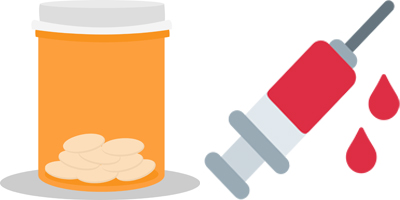Pain Guidelines
Chronic pain and prescription opioid misuse are both major public health problems that exist across the continuum of care. Pain is a major driver for visits to physicians, a major reason for taking medications, a major cause of disability, and a key factor in quality of life and productivity.
Prescription drug abuse continues as a health care problem in our nation and state. Despite the fact that the NYS PDMP (Prescription Drug Monitoring Program, has yielded a 75% improvement in “doctor shopping” for opioid prescriptions, since 2013, death by overdose on prescription opioids remains significant in NYS.
These principles and guidelines aim to identify and promote the essential elements of acute, chronic and palliative pain assessment and management for both children and adults, as well as recognize the risks of opioid use disorder.
Community Principles of Pain Management
The Community Principles of Pain Management (CPPM) provide recommendations for primary care and specialist clinicians who are assessing, managing and prescribing treatment, including opioids, for acute, chronic pain and active cancer treatment, palliative care, and end-of-life care. The principles align with national guidelines developed by a panel of experts and aim to help clinicians meet federal and state regulations.
Complete Pain Toolkit
The complete pain toolkit contains all the professional resources of the Community Principles of Pain Management (CPPM), revised and approved in 2019.
Individual Tools
The individual professional resources contained in the complete CPPM pain toolkit are available to assist clinicians with effective pain management.
Adult Tools
These tools focus on the assessment, diagnosis and development of a treatment plan for the management of pain that support the adult patient’s goals. The tools align with national guidelines that recommend using nonpharmacologic and non-opioid therapies as the initial option for the treatment of pain in adults. When opioids are appropriately indicated, such as cancer pain, guidelines provide for the optimal use that aligns with the adult patient’s goals for their care.

Principles of Pain Management: Adult Guide
Non-Pharmacologic Interventions for Pain
Non-opioid Pharmacologic Therapy for the Treatment of Chronic Pain in Adults
Opioid Guidelines for Adult Patients
Opioid & Sedative Guidelines for Emergency Department & Urgent Care Providers
Equianalgesic Table for Adults
Pediatric Tools
These tools focus on the assessment, diagnosis and development of a treatment plan for the management of pain that support the pediatric patient’s goals. The tools align with national guidelines that recommend using nonpharmacologic and non-opioid therapies as the initial option for the treatment of pain in children and adolescents. When opioids are appropriately indicated, such as cancer pain, guidelines provide for the optimal use that aligns with the pediatric patient’s goals for their care.
Assessment Tools
Pain is complex. A simple score on the pain scale of 1 to 10 does not adequately capture a patient’s pain that may be in various locations and fluctuate over the course of a day and with activity. Assessment is needed to develop the optimal treatment plan that actively engages the patient in self-management of their pain. Establishing patient-centered goals that are SMART (specific, measurable, agreed upon, realistic, and time-based) should focus on improving function and quality of life, as defined by the patient.

PEG Scale: A Three-Item Scale Assessing Pain Intensity and Interference (PEG)
Patient Health Questionnaire (PHQ)
Opioid Risk Tool – Revised (ORT-R)
Principles of Pain Management: Bedside Nursing Assessment Tool
Patient Tools
When opioids are appropriate, patient tools help to educate the patient on taking the opioids correctly and prevent misuse. Unwanted medicines left in the home can endanger others, particularly children, seniors, and pets, and can be subject to drug abuse or accidental ingestion/overdose. Proper disposal of unwanted or expired medications makes a difference for our community and our environment. Safe medication disposal programs have been shown to be the most convenient, cost-effective, and secure method of disposal.
Special Drugs
Some opioid medications require special attention and expertise. For example, methadone is not a first line pain medication and should be used primarily by those prescribers with pain and palliative expertise. Despite representing only 2% of opioid prescriptions, methadone has been involved in 30% of opioid related deaths in recent years. While buprenorphine is an opioid used to treat opioid addiction in higher doses, it is used to treat chronic pain in lower doses.
The CDC Guidelines for Prescribing Opioids for Chronic Pain indicate clinicians should offer naloxone when factors that increase risk for opioid overdose are present, such as history of overdose, history of substance use disorder, higher opioid dosages (≥50 mg oral morphine equivalents/day), or concurrent benzodiazepine use.
References
The CPPM Specialty Advisory Group (SAG) reviewed and updated the list of pertinent current references and websites.
CDC Guideline for Prescribing Opioids for Chronic Pain
Opioids are not first line for chronic pain, even moderate to severe pain, which should be managed with an active approach and non-opioid pain relievers whenever possible. When opioids are indicated, based on a careful risk assessment, combine with an active approach and other measures. Be wary of dose escalation over time due to tolerance.
The CDC guideline provides recommendations for primary care clinicians who are prescribing opioids for chronic pain outside of active cancer treatment, palliative care, and end-of-life care. Additional tools are found on the CDC website.
CDC Resources

CDC Checklist for Prescribing Opioids for Chronic Pain
CDC Pocket Guide: Tapering Opioids for Chronic Pain
CDC Guideline Resources: Clinical Tools
CDC Infographic: Why Guidelines for Primary Care Providers
National Guidelines
While all patients should be screened for pain, identifying a specific etiology for pain is challenging. A complete assessment, including physical, mental, emotional, and spiritual components is helpful in determining the appropriate course of management.
All patients should be actively engaged in self-management of their pain (an ‘active’ approach.) If necessary, therapies that represent a ‘passive’ approach may be utilized to encourage self-management strategies to help achieve patient centered goals.
Geriatrics
Although aging contributes to the likelihood of pain conditions, effective assessment and management can ensure good quality of life. The incidence of pain among older adults varies depending on the cause of pain, other contributing medical conditions and the degree of frailty or ability to care for self. Up to 80 percent of older persons living in long-term care facilities suffer from pain problems. Use of medication in older adults, especially those with multiple medical problems, requires special attention.
American Geriatrics Society 2019 Beers Criteria Update Expert Panel (2019)
Geriatric Pain – Resources and tools for quality pain care
Management of Persistent Pain in Older Adults, American Geriatrics Society (2009)
Cancer
Cancers are among the leading causes of morbidity and mortality worldwide, responsible for 18.1 million new cases and 9.6 million deaths in 2018. Pain is experienced by 55% of patients undergoing anti-cancer treatment and by 66% of patients who have advanced, metastatic, or terminal disease. A recent study in JAMA Oncology found more than one-third of cancer survivors in the United States reported having chronic pain and approximately 16% reported having high-impact chronic pain, which is nearly twice the prevalence seen in the general population. This can be relieved in most cases through medicines and other treatments
Surgery
Pain management after surgery is critically important for all patients, especially for patients with chronic pain and patients with a history of opioid use disorder. For older adults, strong opioid medications can add to complications after surgery.
Upstate New York Surgical Quality Initiative – Surgeons and nurses from 18 upstate New York hospitals got together with the Health Plan through our U[state New York Surgical Quality Initiative. We discussed ways to address the problem of over-prescribing these powerful drugs. The end goal is to reduce opioid dependency and abuse. Our surgeon partners reviewed best practices and reached consensus on appropriate levels of opioids to provide patients. They developed guidelines for 21 surgeries ranging from more intensive total knee replacement surgery to incision-less surgery for bladder tumors.
Guidelines on the Management of Postoperative Pain – A clinical Practice Guideline from the American Pain Society, the American Society of Regional Anesthesia and Pain Medicine, and the American Society of Anesthesiologists’ Committee on Regional Anesthesia, Executive Committee, and Administrative Council
Practice Guidelines for Acute Pain Management in the Perioperative Setting– This report by the American Society of Anesthesiologists Task Force on Acute Pain Management published in 2012 updates previous guidelines published in 2004.
Ultrarestrictive Opioid Prescription Protocol for Pain Management After Gynecologic and Abdominal Surgery – A study at Roswell Park in Buffalo, New York reported in JAMA Network in 2018 revealed opioid prescriptions can be drastically reduced after surgery with no increase in pain.
Persistent Opioid Use after Wisdom Tooth Extraction – Dental surgery is probably the most common surgical procedure performed, followed by knee, hip, and shoulder joint surgery. A study by researchers at the University of Michigan, as reported in JAMA Network in 2018, found young patients 13-30 years old who previously never used opioids but fill an opioid prescription after wisdom tooth extraction are nearly three times as likely to keep using opioids.
National Academies of Sciences, Engineering, and Medicine
The National Academies of Sciences, Engineering, and Medicine (NASEM) provide nonpartisan, objective guidance for decision makers on pressing issues. Founded in 1863, NASEM marshals the energy and intellect of the nation’s critical thinkers to respond to policy challenges with science, engineering, and medicine at their core.
When faced with a complex question, NASEM brings together experts from across disciplines to look at the evidence with fresh eyes and openness to insights from other fields. These study committees survey the landscape of relevant research, hold public meetings to gather information, and deliberate to reach consensus, which results in a shared understanding of what the evidence reveals and the best path forward.
NASEM shields committee deliberations and conclusions from influence by sponsors and special interests and makes certain each report undergoes rigorous peer review to ensure that the advice is grounded in the best available evidence. This provides policy makers assurance that the results reflect the facts and the combined expertise of the science, engineering, and medical communities.
First do no harm: Marshaling clinician leadership to counter the opioid epidemic
President’s Forum: The U.S. Opioid Epidemic
Pain Management for People with Serious Illness in the Context of the Opioid Use Disorder Epidemic
Acknowledgement
The Community Principles of Pain Management (CPPM) were developed by the CPPM Specialty Advisory Group (SAG) initially in 2002 and are reviewed and approved every other year by the SAG. The CPPM were approved by the Excellus BlueCross BlueShield Health Care Quality Monitoring Committee and the Monroe County Medical Society Quality Collaborative in April 2019, with the next revision scheduled for 2021. Special thanks to the Special Advisory Group (SAG), 2019.



